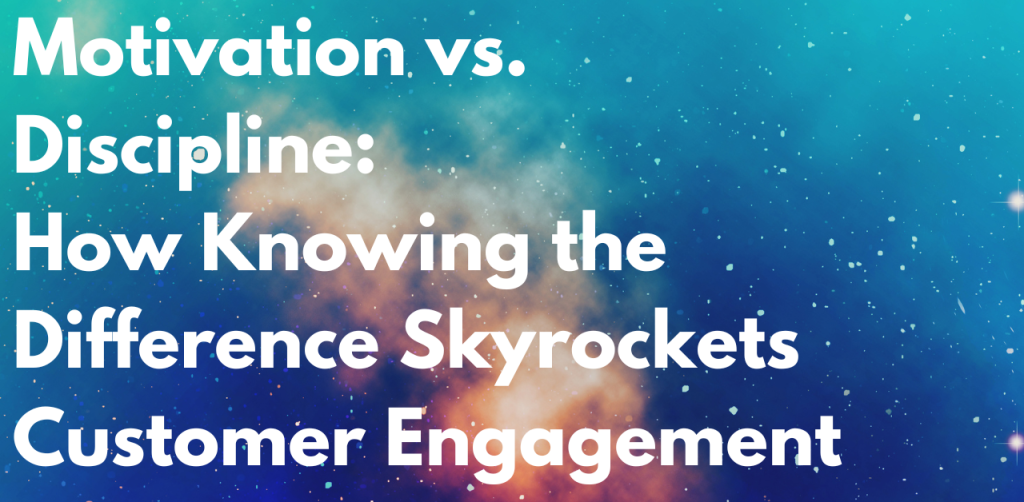 When you’re working with customers, whatever your role (CSM, Sales, Account Management, Consultant, etc.), you may find yourself acting as a coach.
When you’re working with customers, whatever your role (CSM, Sales, Account Management, Consultant, etc.), you may find yourself acting as a coach.
To be an effective coach, you need to strike the right balance between motivation and discipline.
Which means we need to explore the differences between motivation and discipline, and how to apply them effectively to engage your human customers.
Source of Inspiration
Two things inspired me to talk about this topic.
First, this is top-of-mind since we’re entering week 3 of our CSM training at Impact Academy. Last week we talked about Goal Discovery and this week we go deeper into the Why behind goals, how to motivate action, and build Joint Accountability.
But I also spend a lot of time in the Sales, Fitness, and Brazilian Jiujitsu worlds where a common trope among coaches and “influencers” is, “you don’t need motivation, just discipline.”
But even famed motivational Sales speaker and author Zig Ziglar said, “People often say that motivation doesn’t last. Well, neither does bathing – that’s why we recommend it daily.”
So let’s explore this.
So, You Don’t Need Motivation?
It’s good to remember that the motivation for those saying, “you don’t need motivation, just discipline” is to position themselves a certain way: tough, independent, whatever.
In other words, there’s ALWAYS internal motivation for whatever action you take; even if that motivation is to appear as if you don’t need motivation.
Of course you see that repeated in business, too, especially around Entrepreneurship, Sales, and anything to do with hustle culture.
No successful person was ever motivated to be successful; they were just disciplined.
What a lovely-sounding bunch of garbage.
In fact, it would be easy to just call BS on all of this and move on, but if we do that, we’re missing out on some powerful levers we can pull to make the customers we work with successful.
Motivation vs. Discipline: The Basics
Motivation is the driving force that compels human people to take action.
Discipline is the consistent pattern of behavior designed to achieve a desired outcome.
Going back to the fitness world for a second – again, a realm where motivation and discipline are often discussed and confused – motivation would be the desire to achieve a goal – to deadlift 200kg by May 1 – while discipline is the act of going to the gym consistently and following the program, regardless of how you feel on any given day.
Understanding these concepts is essential when working with customers, especially in situations where you need them to take action that’s time-consuming, boring, technical, functional, or otherwise just not “what they signed-up to do.”
When it comes to the customer’s success, the idea of discipline can be applied by laying out a clear plan with the customer and creating joint accountability to ensure they follow it.
However, understanding their motivation is just as important; a well-structured plan will fall short if the customer lacks motivation.
But since the customer never actually lacks motivation; the problem is that you’re likely looking for – or attempting to conjure-up for them – the wrong type.
Internal vs. External Motivation
Internal motivation comes from within (as the name implies), driving a person to reach their goals.
But “internal” motivation could also be internal to their team or org, or the company they work for.
External motivation, on the other hand, comes from outside sources that should add to one’s internal motivation, not replace it.
External motivation is not enough. It’s never enough. Ever.
In your customer-facing role, you may sometimes act as an external motivator for your customers, but this is exhausting and unsustainable in the long run if it is the sole source of motivation for them.
To avoid burnout, you must understand your customer’s internal motivation – the WHY behind their goals – and get them to draw on that to fuel their disciplined approach to achieving their goals.
Of course, you don’t have to be the sole source of external motivation.
Social Proof as External Motivation
In fact, if you can have customer stories lined up – social proof as we call it – you can rely on that to say, “hey, look what other customers that are in the exact same situation as you that have the same characteristics as you did and the results they got.”
Social proof can be incredibly motivating. Of course, on its own it’s not enough.
But if you can align that with their internal motivation, social proof becomes a multiplier, not just for the customer’s success, but your’s, too.
By tapping into their internal motivation, you can better support them in their journey toward success… without destroying yourself in the process.
Internal Motivation + Discipline + External Motivation = Success
External motivation cannot overcome a lack of internal motivation.
The good news is everybody has internal motivation; it’s always there, just not always known.
Your job is to surface it for and with the customer.
Once you get them to tap into their internal motivation, a disciplined approach to achieving their goals becomes so much easier to implement and stick to.
Once those are in place, feel free to add on your external motivation. Cheer them on. Support their efforts. Advocate for them. Elevate their status.




